Sham M. Kakade
The Role of Sparsity for Length Generalization in Transformers
Feb 24, 2025

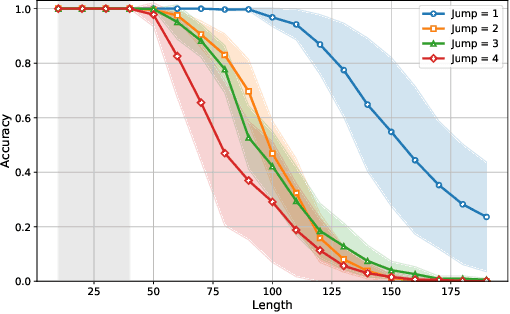
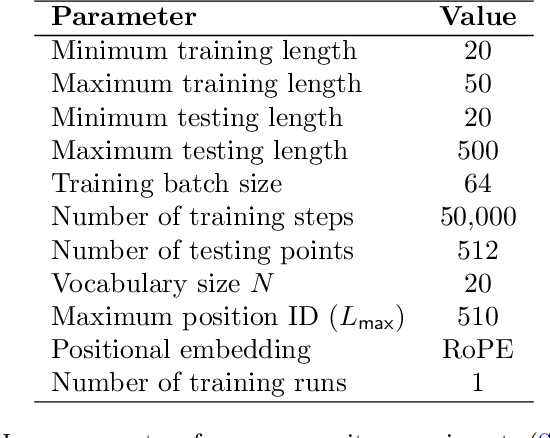
Abstract:Training large language models to predict beyond their training context lengths has drawn much attention in recent years, yet the principles driving such behavior of length generalization remain underexplored. We propose a new theoretical framework to study length generalization for the next-token prediction task, as performed by decoder-only transformers. Conceptually, we show that length generalization occurs as long as each predicted token depends on a small (fixed) number of previous tokens. We formalize such tasks via a notion we call $k$-sparse planted correlation distributions, and show that an idealized model of transformers which generalize attention heads successfully length-generalize on such tasks. As a bonus, our theoretical model justifies certain techniques to modify positional embeddings which have been introduced to improve length generalization, such as position coupling. We support our theoretical results with experiments on synthetic tasks and natural language, which confirm that a key factor driving length generalization is a ``sparse'' dependency structure of each token on the previous ones. Inspired by our theory, we introduce Predictive Position Coupling, which trains the transformer to predict the position IDs used in a positional coupling approach. Predictive Position Coupling thereby allows us to broaden the array of tasks to which position coupling can successfully be applied to achieve length generalization.
Mixture of Parrots: Experts improve memorization more than reasoning
Oct 24, 2024


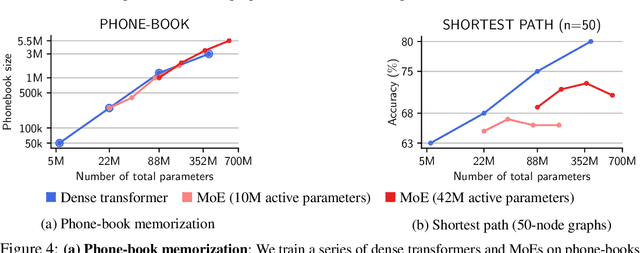
Abstract:The Mixture-of-Experts (MoE) architecture enables a significant increase in the total number of model parameters with minimal computational overhead. However, it is not clear what performance tradeoffs, if any, exist between MoEs and standard dense transformers. In this paper, we show that as we increase the number of experts (while fixing the number of active parameters), the memorization performance consistently increases while the reasoning capabilities saturate. We begin by analyzing the theoretical limitations of MoEs at reasoning. We prove that there exist graph problems that cannot be solved by any number of experts of a certain width; however, the same task can be easily solved by a dense model with a slightly larger width. On the other hand, we find that on memory-intensive tasks, MoEs can effectively leverage a small number of active parameters with a large number of experts to memorize the data. We empirically validate these findings on synthetic graph problems and memory-intensive closed book retrieval tasks. Lastly, we pre-train a series of MoEs and dense transformers and evaluate them on commonly used benchmarks in math and natural language. We find that increasing the number of experts helps solve knowledge-intensive tasks, but fails to yield the same benefits for reasoning tasks.
Multi-Agent Reinforcement Learning from Human Feedback: Data Coverage and Algorithmic Techniques
Sep 04, 2024



Abstract:We initiate the study of Multi-Agent Reinforcement Learning from Human Feedback (MARLHF), exploring both theoretical foundations and empirical validations. We define the task as identifying Nash equilibrium from a preference-only offline dataset in general-sum games, a problem marked by the challenge of sparse feedback signals. Our theory establishes the upper complexity bounds for Nash Equilibrium in effective MARLHF, demonstrating that single-policy coverage is inadequate and highlighting the importance of unilateral dataset coverage. These theoretical insights are verified through comprehensive experiments. To enhance the practical performance, we further introduce two algorithmic techniques. (1) We propose a Mean Squared Error (MSE) regularization along the time axis to achieve a more uniform reward distribution and improve reward learning outcomes. (2) We utilize imitation learning to approximate the reference policy, ensuring stability and effectiveness in training. Our findings underscore the multifaceted approach required for MARLHF, paving the way for effective preference-based multi-agent systems.
Eliminating Position Bias of Language Models: A Mechanistic Approach
Jul 01, 2024Abstract:Position bias has proven to be a prevalent issue of modern language models (LMs), where the models prioritize content based on its position within the given context. This bias often leads to unexpected model failures and hurts performance, robustness, and reliability across various applications. Our mechanistic analysis attributes the position bias to two components employed in nearly all state-of-the-art LMs: causal attention and relative positional encodings. Specifically, we find that causal attention generally causes models to favor distant content, while relative positional encodings like RoPE prefer nearby ones based on the analysis of retrieval-augmented question answering (QA). Further, our empirical study on object detection reveals that position bias is also present in vision-language models (VLMs). Based on the above analyses, we propose to ELIMINATE position bias caused by different input segment orders (e.g., options in LM-as-a-judge, retrieved documents in QA) in a TRAINING-FREE ZERO-SHOT manner. Our method changes the causal attention to bidirectional attention between segments and utilizes model attention values to decide the relative orders of segments instead of using the order provided in input prompts, therefore enabling Position-INvariant inferencE (PINE) at the segment level. By eliminating position bias, models achieve better performance and reliability in downstream tasks where position bias widely exists, such as LM-as-a-judge and retrieval-augmented QA. Notably, PINE is especially useful when adapting LMs for evaluating reasoning pairs: it consistently provides 8 to 10 percentage points performance gains in most cases, and makes Llama-3-70B-Instruct perform even better than GPT-4-0125-preview on the RewardBench reasoning subset.
Transcendence: Generative Models Can Outperform The Experts That Train Them
Jun 17, 2024Abstract:Generative models are trained with the simple objective of imitating the conditional probability distribution induced by the data they are trained on. Therefore, when trained on data generated by humans, we may not expect the artificial model to outperform the humans on their original objectives. In this work, we study the phenomenon of transcendence: when a generative model achieves capabilities that surpass the abilities of the experts generating its data. We demonstrate transcendence by training an autoregressive transformer to play chess from game transcripts, and show that the trained model can sometimes achieve better performance than all players in the dataset. We theoretically prove that transcendence is enabled by low-temperature sampling, and rigorously assess this experimentally. Finally, we discuss other sources of transcendence, laying the groundwork for future investigation of this phenomenon in a broader setting.
Scaling Laws in Linear Regression: Compute, Parameters, and Data
Jun 12, 2024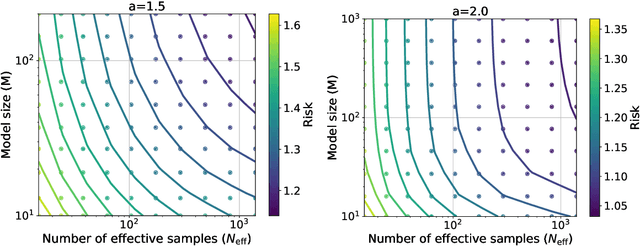

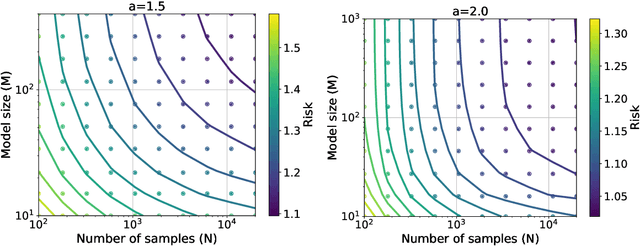

Abstract:Empirically, large-scale deep learning models often satisfy a neural scaling law: the test error of the trained model improves polynomially as the model size and data size grow. However, conventional wisdom suggests the test error consists of approximation, bias, and variance errors, where the variance error increases with model size. This disagrees with the general form of neural scaling laws, which predict that increasing model size monotonically improves performance. We study the theory of scaling laws in an infinite dimensional linear regression setup. Specifically, we consider a model with $M$ parameters as a linear function of sketched covariates. The model is trained by one-pass stochastic gradient descent (SGD) using $N$ data. Assuming the optimal parameter satisfies a Gaussian prior and the data covariance matrix has a power-law spectrum of degree $a>1$, we show that the reducible part of the test error is $\Theta(M^{-(a-1)} + N^{-(a-1)/a})$. The variance error, which increases with $M$, is dominated by the other errors due to the implicit regularization of SGD, thus disappearing from the bound. Our theory is consistent with the empirical neural scaling laws and verified by numerical simulation.
Superposed Decoding: Multiple Generations from a Single Autoregressive Inference Pass
May 29, 2024Abstract:Many applications today provide users with multiple auto-complete drafts as they type, including GitHub's code completion, Gmail's smart compose, and Apple's messaging auto-suggestions. Under the hood, language models support this by running an autoregressive inference pass to provide a draft. Consequently, providing $k$ drafts to the user requires running an expensive language model $k$ times. To alleviate the computation cost of running $k$ inference passes, we propose Superposed Decoding, a new decoding algorithm that generates $k$ drafts at the computation cost of one autoregressive inference pass. We achieve this by feeding a superposition of the most recent token embeddings from the $k$ drafts as input to the next decoding step of the language model. At every inference step we combine the $k$ drafts with the top-$k$ tokens to get $k^2$ new drafts and cache the $k$ most likely options, using an n-gram interpolation with minimal compute overhead to filter out incoherent generations. Our experiments show that $k$ drafts from Superposed Decoding are at least as coherent and factual as Nucleus Sampling and Greedy Decoding respectively, while being at least $2.44\times$ faster for $k\ge3$. In a compute-normalized setting, user evaluations demonstrably favor text generated by Superposed Decoding over Nucleus Sampling. Code and more examples open-sourced at https://github.com/RAIVNLab/SuperposedDecoding.
Matching the Statistical Query Lower Bound for k-sparse Parity Problems with Stochastic Gradient Descent
Apr 18, 2024Abstract:The $k$-parity problem is a classical problem in computational complexity and algorithmic theory, serving as a key benchmark for understanding computational classes. In this paper, we solve the $k$-parity problem with stochastic gradient descent (SGD) on two-layer fully-connected neural networks. We demonstrate that SGD can efficiently solve the $k$-sparse parity problem on a $d$-dimensional hypercube ($k\le O(\sqrt{d})$) with a sample complexity of $\tilde{O}(d^{k-1})$ using $2^{\Theta(k)}$ neurons, thus matching the established $\Omega(d^{k})$ lower bounds of Statistical Query (SQ) models. Our theoretical analysis begins by constructing a good neural network capable of correctly solving the $k$-parity problem. We then demonstrate how a trained neural network with SGD can effectively approximate this good network, solving the $k$-parity problem with small statistical errors. Our theoretical results and findings are supported by empirical evidence, showcasing the efficiency and efficacy of our approach.
Repeat After Me: Transformers are Better than State Space Models at Copying
Feb 01, 2024Abstract:Transformers are the dominant architecture for sequence modeling, but there is growing interest in models that use a fixed-size latent state that does not depend on the sequence length, which we refer to as "generalized state space models" (GSSMs). In this paper we show that while GSSMs are promising in terms of inference-time efficiency, they are limited compared to transformer models on tasks that require copying from the input context. We start with a theoretical analysis of the simple task of string copying and prove that a two layer transformer can copy strings of exponential length while GSSMs are fundamentally limited by their fixed-size latent state. Empirically, we find that transformers outperform GSSMs in terms of efficiency and generalization on synthetic tasks that require copying the context. Finally, we evaluate pretrained large language models and find that transformer models dramatically outperform state space models at copying and retrieving information from context. Taken together, these results suggest a fundamental gap between transformers and GSSMs on tasks of practical interest.
Hardness of Independent Learning and Sparse Equilibrium Computation in Markov Games
Mar 22, 2023Abstract:We consider the problem of decentralized multi-agent reinforcement learning in Markov games. A fundamental question is whether there exist algorithms that, when adopted by all agents and run independently in a decentralized fashion, lead to no-regret for each player, analogous to celebrated convergence results in normal-form games. While recent work has shown that such algorithms exist for restricted settings (notably, when regret is defined with respect to deviations to Markovian policies), the question of whether independent no-regret learning can be achieved in the standard Markov game framework was open. We provide a decisive negative resolution this problem, both from a computational and statistical perspective. We show that: - Under the widely-believed assumption that PPAD-hard problems cannot be solved in polynomial time, there is no polynomial-time algorithm that attains no-regret in general-sum Markov games when executed independently by all players, even when the game is known to the algorithm designer and the number of players is a small constant. - When the game is unknown, no algorithm, regardless of computational efficiency, can achieve no-regret without observing a number of episodes that is exponential in the number of players. Perhaps surprisingly, our lower bounds hold even for seemingly easier setting in which all agents are controlled by a a centralized algorithm. They are proven via lower bounds for a simpler problem we refer to as SparseCCE, in which the goal is to compute a coarse correlated equilibrium that is sparse in the sense that it can be represented as a mixture of a small number of product policies. The crux of our approach is a novel application of aggregation techniques from online learning, whereby we show that any algorithm for the SparseCCE problem can be used to compute approximate Nash equilibria for non-zero sum normal-form games.
 Add to Chrome
Add to Chrome Add to Firefox
Add to Firefox Add to Edge
Add to Edge